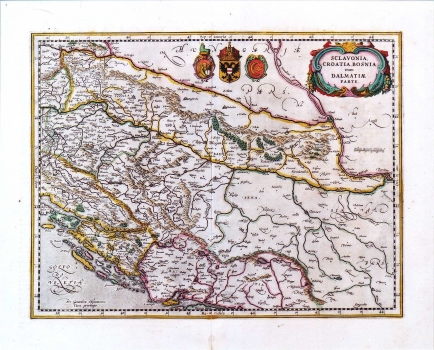BLAEU, GUILIELMUS: MAP OF SLAVONIA, CROATIA, BOSNIA AND PARTS OF DALMATIA
Inventory number 80
Author: BLAEU, WILLEM
Original title: Sclavonia, Croatia, Bosnia cum Dalmatiae parte/Gerhard Mercator
Publishing year: 1625
Place of publishing and publisher: Amsterdam
Format: 33,5x46 cm
Technique: Partially coloured copper engraving
This Mercator's map's issue was published by Willem Janszoon Blaeu in his atlas "Atlas Novus" in 1625. From the previous issues differs only by its cartouche design ( ref. catalogue Nos. 104, 6 and 43).
BLAEU, WILLEM
After Ortelius' death, his printing house continued under direction of GUILIELMUS BLAEU (1571-1638), a great Dutch cartographer and publisher who reissued several editions of Ortelius' atlases which he had revised and added some more maps. He had begun its career in Amsterda where at first he centered his activity in construction of measuring instruments and globe model producing. In 1599 he opens his workshop in Amsterdam. He inherited Ortelius' copper plates, so he was able to start as early as from the beginning of the 17th century with publishing and enlarging of the original Ortelius' atlas. From 1629 on, Blaeu's printing house came into possession of the Hondious' printing plates too. While he was continuing to publish Ortelius' and Hondius' plates, in 1629, Blaeu issues the first atlas of his own that included, of course, a number of maps made by foreign cartographers. But, beside Mercator-Hondius plates, Blaeu made 17 plates by himself. The summa of his work is represented in his atlas "Novus Atlas" of 1634, with its four new editions of 1635. His sons, Cornelius (approx. 1610-1648) and Johannes (1596-1673) continue with their father's work Johannes Blaeu publishes in 1649 his edition of "Atlas Blaviane" in 6 volumes, in 1662 "Atlas Maior" in 11 volumes and in 1663 "Le Grand atlas ou Cosmographie Blaviana" in 11 volumes. In 1638 Johannes Blaeu became a cartographer at the Dutch East India Company, and upon that his workshop develops into a modern cartographic factory. Blaeu's printing house was destroyed in the fire in 1672. A minor part of copper engraving plates that left acquired a Dutch de Witt family.

